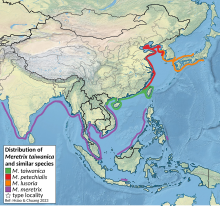Meretrix lusoria
| Meretrix lusoria | |
|---|---|

| |
| Scientific classification | |
| Domain: | Eukaryota |
| Kingdom: | Animalia |
| Phylum: | Mollusca |
| Class: | Bivalvia |
| Order: | Venerida |
| Family: | Veneridae |
| Genus: | Meretrix |
| Species: | M. lusoria
|
| Binomial name | |
| Meretrix lusoria Röding, 1798
| |
Meretrix lusoria, the hamaguri, Asian hard clam or common Orient clam, is a species of saltwater clam, a marine bivalve mollusk in the family Veneridae, the Venus clams. This species is native to Asia, originally described around the waters of Japan.[1] It is commercially exploited for sushi, and its shells are traditionally used to make white go stones.
The hamaguri clam is the subject of a haiku by Matsuo Bashō.[2]
Taxonomic difficulties
[edit]
Meretrix lusoria is morphologically similar to a number of closely related species,[1] making identification and reports of distribution quite confusing. Less precise sources may describe a large range in East Asia, in waters tropic to temperate.[3] However, as Hsiao & Chuang (2023) demonstrated using molecular (nuclear + mtDNA) and multi-variate morphological means, it is possible to distinguish several species:
- Meretrix lusoria, originally described around Japan, is distributed in the waters of Japan and South Korea.[1]
- Metetrix petechialis is distributed in China's East and Yellow seas.[1]
- Meretrix taiwanica, misidentified as others on the list until 2023, is found around Taiwan and southern China.[1][4]
- Meretrix meretrix, originally described by Linnaeus in the Indian Ocean, is found around Indian Ocean and Southeast Asia.[1]
There is one report in 2022 of M. lusoria appearing in Sarawak (Malaysian Borneo). The identification was confirmed by mtDNA phylogeny matching to Japanese M. lusoria. Interestingly, what appeared morphologically to be M. meretrix and M. lyrata at the same site gave very similar mtDNA results.[5]
See also
[edit]- Kai-awase, a Japanese game with hamaguri shells
References
[edit]- ^ a b c d e f g Hsiao, Sheng-Tai; Chuang, Shih-Chang (2023). "Meretrix taiwanica (Bivalvia: Veneridae), a previously misidentified new species in Taiwan". Molluscan Research. 43 (1). Taylor & Francis Group: 12–21. Bibcode:2023MollR..43...12H. doi:10.1080/13235818.2023.2189428.
- ^ "Closure, the final haiku". 2019-09-26.
- ^ Hagan, Melissa. "NEMESIS Database Species Summary". invasions.si.edu. Retrieved 2017-10-24.
- ^ PFLUGHOEFT, ASPEN. "New species was hiding in plain sight and being raised on Taiwanese farms, experts say". miamiherald.com. Miami Herald. Retrieved 13 April 2023.
- ^ Idris, Mohd Hanafi; Abu Hena, Mustafa Kamal; Hamli, Hadi; Rajaee, Amy; Al-Asif, Abdulla- (16 December 2022). "The molecular approach reveals the relationship among Venus clams (Meretrix spp.) community in Malaysia". Biotropia. 29 (3): 213–224. doi:10.11598/btb.2022.29.3.1583.
Text is available under the CC BY-SA 4.0 license; additional terms may apply.
Images, videos and audio are available under their respective licenses.
